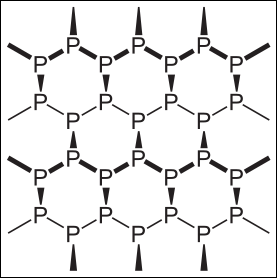Technologies to separate black phosphorus into ultrathin nanosheets emerged, and expectations for next-generation electronic device materials will increase

Among phosphorous allotropes, relatively stable black phosphorus has been shown to possibly be applied to various kinds of electronics materials by making it into a nanosheet shape having only a few atoms, but it is easy and massive for nanosheets There was a difficulty in making it. But,Trinity College (University of Dublin)Research Group has announced that it has developed a method for easily making black phosphorus nanosheets.
Liquid exfoliation of solvent-stabilized black phosphorus: applications beyond electronics
http://arxiv.org/abs/1501.01881
Black Phosphorous: the Birth of a New Wonder Material | MIT Technology Review
http://www.technologyreview.com/view/534166/black-phosphorous-the-birth-of-a-new-wonder-material/
GrapheneAs a representative, materials having only several atomic levels of thickness that can be utilized for various electronic devices, so-called "Two-dimensional functional material"Is one of the most noteworthy areas of present material engineering, and it has black phosphorusBand gapAlthough it was expected to develop next-generation field effect transistors that make use of it, black phosphorus nanosheet "PhosphoreneIsScotch tape methodIt was a big bottleneck to practical use that only small amounts could be produced by.

However, at the Trinity CollegeDamien HanlonDr. et al.'s research group devised a method that can produce large quantities while controlling the thickness of black phosphorus. Dr. Hanlong succeeded in exfoliating black phosphorus in nanosheet form by sonicating black phosphorus in the solvent of N-cyclohexyl-2-pyrrolidone. The black phosphorus sheet peeled in the form of nanosheets is separated by a centrifugal separator, and it is possible to take out a high quality nanosheet having only a few atoms in thickness. "By using this technique, we can produce a large amount of black phosphorus nanosheets," Dr. Hanlong says.

Unlike graphene, black phosphorus having a large band gap is expected to be utilized for electronic devices such as transistors, but black phosphorus sheets invented by Dr. Hanlong and others are expected to be applied to various electronics. For example, when a black phosphorus nanosheet is added to a film of polyvinyl chloride, the strength is doubled, the tensile toughness (toughness) is strengthened to 6 times, and the black phosphor nanosheet is larger than the grapheneNonlinear optical propertiesIt turns out to show. In addition, since the electric resistance is greatly increased by touching ammonia, 80PpbIt is also known that it can be used as a sensitive ammonia detection material capable of detecting a large amount of ammonia.
This research will enable mass production of black phosphorus thin film sheets, so research on nanotechnology using black phosphorus seems to be further booming.
Related Posts:
in Science, Posted by darkhorse_log






